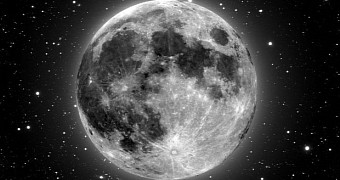In a study published in the science journal Nature yesterday, April 8, researchers at the University of Maryland in the US propose a new theory on the formation of the Moon, our planet's natural satellite.
Well, the study is not so much a brand new theory about how the Moon came into being as it is an upgraded and more detailed version of the scenario brought forth by planetary scientists to explain how and why our natural satellite formed.
The baseline story and its flaws
It's agreed that the Moon must have formed sometime within the first 150 million years following the birth of the Solar System as a result of an impact between a celestial body about the size of Mars and our planet.
The idea is that this impact was powerful enough to birth a massive cloud of rock and debris that eventually settled down, coalesced and created the Moon.
The trouble is that, if this theory is correct, then the Moon's geological profile should be different to that of Earth. It should resemble that of Theia, the body believed to have collided with our planet to form the Moon.
This isn't the case. As explained by University of Maryland researcher Richard Walker and his colleagues, analyses of rocks thus far recovered from the Moon indicate that Earth and the Moon are surprising alike.
“The Mars-sized body that created the moon is expected to have been very different, so the conundrum is that Earth and the moon shouldn’t be as similar as they are,” the specialist said in an interview.
A possible explanation for this similarity
Some scientists theorize that the reason the Moon and Earth are so alike is that Theia itself was similar to our planet. The University of Maryland team aren't satisfied with this explanation.
They say that, having carried out a series of simulations, they found that the Moon's makeup is best explained by a Theia-Earth collision far more violent than previously assumed.
Specifically, the researchers argue that, when Theia crashed into our planet, the impact was powerful enough to kick up a cloud of debris that kept swirling and swirling until it became almost homogeneous and only then formed the Moon.
Part of the debris comprising this smoldering cloud got pulled by Earth's gravity and became part of our planet, and the remaining created the Moon. The scientists say this explains the similarities between these two celestial bodies.
Basically, our planet was partly destroyed by the impact and then put itself back together. While regenerating itself, so to speak, it swallowed debris originating from Theia. Whatever debris was left formed the Moon.
“This means that, right after the moon formed, it had exactly the same isotopic composition as Earth’s mantle,” University of Maryland researcher Richard Walker said in a statement.
Why Earth and the Moon aren't identical
True, our planet and its natural satellite are freakishly similar. Still, the fact remains that they are not identical. As Richard Walker explained, they most likely were eons ago, but this is no longer the case.
The specialists suspect that this is because, following the formation of the Moon, both Earth and its brand new satellite gathered additional material that altered their individual geological profiles ever so slightly.

 14 DAY TRIAL //
14 DAY TRIAL // 
